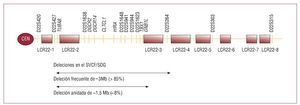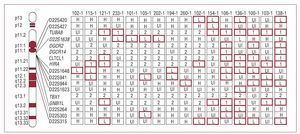Introducción y objetivos. La comunicación interventricular (CIV) es una de las principales formas de cardiopatía congénita (CPC) en los individuos con el síndrome de deleción del cromosoma 22q11 del Homo sapiens (HSA22q11). Con objeto de identificar los genes candidatos situados en el HSA22q11 asociados a la CIV, se analizó la pérdida de heterocigosis (LOH) mediante determinación del genotipo de microsatélites y análisis de dosis de siete genes candidatos. Métodos. Se investigó a un total de 82 familias con CPC, en las que había 261 individuos (85 pacientes, 176 hermanos y progenitores). Se efectuó un examen de detección de la LOH en la región HSA22q11 mediante determinación del genotipo de microsatélites (n = 10). Las estrategias de bioinformática permitieron caracterizar más detalladamente siete genes candidatos situados en esa región. Se aplicaron reacciones en cadena de polimerasa cuantitativas para el análisis de dosis a siete genes candidatos de 16 pacientes con LOH de HSA22q11. Resultados. En 42 (49,4%) de los 85 pacientes con CPC se identificó la presencia de al menos una LOH en la región HSA22q11. Se observaron LOH de HSA22q11 en 17 de 29 pacientes con CIV y en 3 de 4 familias con ambos hijos afectados por CPC. El análisis de dosis realizado para siete genes candidatos indicó una deleción heterocigota recurrente de los genes HIRA, GNB1L y TUBA8 en 16 pacientes con CIV que presentaban LOH de HSA22q11. Conclusiones. La determinación del genotipo de microsatélites identificó la LOH de HSA22q11 en varios tipos de CPC. La deleción heterocigota de los genes HIRA, GNB1L o TUBA8 podría desempeñar un papel importante en el desarrollo del tabique ventricular. Dado que la CPC puede ser una enfermedad familiar, el examen de detección de LOH de HSA22q en los hermanos del caso índice será útil para un diagnóstico y un tratamiento precoces.
Palabras clave
Cardiopatías congénitas
Análisis de dosis génica
Genotipo 22q11del
Este artículo solo puede leerse en
pdf
Bibliografía
[1]
Hoffman JI..
Incidence of congenital heart disease: II. Prenatal incidence..
Pediatr Cardiol, (1995), 16 pp. 155-65
[2]
Pierpont ME, Basson CT, Benson DW Jr, Gelb BD, Giglia TM, Goldmuntz E, et al..
Genetic basis for congenital heart defects: current knowledge: a scientific statement from the American Heart Association Congenital Cardiac Defects Committee, Council on Cardiovascular Disease in the Young: endorsed by the American Academy of Pediatrics..
Circulation, (2007), 115 pp. 3015-38
[3]
Hofbeck M, Rauch A, Buheitel G, Leipold G, Von der Emde J, Pfeiffer R, et al..
Monosomy 22q11 in patients with pulmonary atresia, ventricular septal defect, and major aortopulmonary collateral arteries..
Heart, (1998), 79 pp. 180-5
[4]
McElhinney DB, McDonald-McGinn D, Zackai EH, Goldmuntz E..
Cardiovascular anomalies in patients diagnosed with a chromosome 22q11 deletion beyond 6 months of age..
Pediatrics, (2001), 108 pp. E104
[5]
Shi YR, Hsieh KS, Wu JY, Lee CC, Tsai CH, Yu MT, et al..
Genetic analysis of chromosome 22q112 markers in congenital heart disease..
J Clin Lab Anal, (2003), 17 pp. 28-35
[6]
Worthington S, Bower C, Harrop K, Loh J, Walpole I..
22q11 deletions in patients with conotruncal heart defects..
J Paediatr Child Health, (1998), 34 pp. 438-43
[7]
Schiaffino S, Dallapiccola B, Di Lisi R..
Molecular genetics of congenital heart disease. A problem of faulty septation..
Circ Res, (1999), 84 pp. 247-9
[8]
Kessler-Icekson G, Birk E, Weintraub AY, Barhum Y, Kotlyar V, Schlesinger H, et al..
Association of tetralogy of Fallot with a distinct region of del22q112..
Am J Med Genet, (2002), 107 pp. 294-8
[9]
Khositseth A, Tocharoentanaphol C, Khowsathit P, Ruangdaraganon N..
Chromosome 22q11 deletions in patients with conotruncal heart defects..
Pediatr Cardiol, (2005), 26 pp. 570-3
[10]
McElhinney DB, Driscoll DA, Levin ER, Jawad AF, Emanuel BS, Goldmuntz E..
Chromosome 22q11 deletion in patients with ventricular septal defect: frequency and associated cardiovascular anomalies..
Pediatrics, (2003), 112 pp. e472
[11]
Voigt R, Maier-Weidmann M, Lange PE, Haaf T..
Chromosome 10p13-14 and 22q11 deletion screening in 100 patients with isolated and syndromic conotruncal heart defects..
J Med Genet, (2002), 39 pp. e16
[12]
Beauchesne LM, Warnes CA, Connolly HM, Ammash NM, Grogan M, Jalal SM, et al..
Prevalence and clinical manifestations of 22q112 microdeletion in adults with selected conotruncal anomalies..
J Am Coll Cardiol, (2005), 45 pp. 595-8
[13]
Shi YR, Hsieh KS, Wu JY, Lee CC, Tsai CH, Tsai FJ..
Molecular analysis of syndromic congenital heart disease using short tandem repeat markers and semiquantitative polymerase chain reaction method..
Pediatr Int, (2002), 44 pp. 264-8
[14]
Vittorini S, Sacchelli M, Iascone MR, Collavoli A, Storti S, Giusti A, et al..
Molecular characterization of chromosome 22 deletions by short tandem repeat polymorphism (STRP) in patients with conotruncal heart defects..
Clin Chem Lab Med, (2001), 39 pp. 1249-58
[15]
Li YC, Korol AB, Fahima T, Beiles A, Nevo E..
Microsatellites: genomic distribution, putative functions and mutational mechanisms: a review..
Mol Ecol, (2002), 11 pp. 2453-65
[16]
Wheeler DL, Barrett T, Benson DA, Bryant S H, Canese K, Chetvernin V, et al..
Database resources of the National Center for Biotechnology Information..
Nucleic Acids Res, (2006), 34 pp. D173-80
[17]
Birney E, Andrews D, Caccamo M, Chen Y, Clarke L, Coates G, et al..
Ensembl 2006..
Nucleic Acids Res, (2006), 34 pp. D556-61
[18]
Hinrichs AS, Karolchik D, Baertsch R, Barber G P, Bejerano G, Clawson H, et al..
The UCSC Genome Browser Database: update 2006..
Nucleic Acids Res, (2006), 34 pp. D590-8
[19]
Boeckmann B, Bairoch A, Apweiler R, Blatter M C, Estreicher A, Gasteiger E, et al..
The SWISS-PROT protein knowledgebase and its supplement TrEMBL in 2003..
Nucleic Acids Res, (2003), 31 pp. 365-70
[20]
Al-Shahrour F, Minguez P, Vaquerizas JM, Conde L, Dopazo J..
BABELOMICS: a suite of web tools for functional annotation and analysis of groups of genes in high-throughput experiments..
Nucleic Acids Res, (2005), 33 pp. W460-4
[21]
Buza TJ, McCarthy FM, Wang N, Bridges SM, Burgess SC..
Gene ontology annotation quality analysis in model eukaryotes..
Nucleic Acids Res, (2008), 36 pp. e12
[22]
Livak KJ, Schmittgen TD..
Analysis of relative gene expression data using real-time quantitative PCR and the 2(-Delta Delta C(T)) Method..
Methods, (2001), 25 pp. 402-8
[23]
Batra RS, Hatchwell E, Rider S, Brown R, Brown GK, Craig IW..
Localization of human liver 6-phosphofructo-2-kinase/ fructose-2,6-bisphosphatase (PFKFB1) within a YAC contig in Xp1121..
Genomics, (1997), 40 pp. 358-61
[24]
Senchenko V, Liu J, Braga E, Mazurenko N, Loginov W, Seryogin Y, et al..
Deletion mapping using quantitative real-time PCR identifies two distinct 3p213 regions affected in most cervical carcinomas..
Oncogene, (2003), 22 pp. 2984-92
[25]
Liao J, Kochilas L, Nowotschin S, Arnold JS, Aggarwal VS, Epstein JA, et al..
Full spectrum of malformations in velocardio-facial syndrome/DiGeorge syndrome mouse models by altering Tbx1 dosage..
Hum Mol Genet, (2004), 13 pp. 1577-85
[26]
Lindsay EA..
Chromosomal microdeletions: dissecting del22q11 syndrome..
Nat Rev Genet, (2001), 2 pp. 858-68
[27]
Saitta SC, Harris SE, McDonald-McGinn DM, Emanuel BS, Tonnesen MK, Zackai EH, et al..
Independent de novo 22q112 deletions in first cousins with DiGeorge/velocardiofacial syndrome..
Am J Med Genet A, (2004), 124 pp. 313-7
[28]
Rauch A, Zink S, Zweier C, Thiel CT, Koch A, Rauch R, et al..
Systematic assessment of atypical deletions reveals genotype-phenotype correlation in 22q112..
J Med Genet, (2005), 42 pp. 871-6
[29]
Iserin L, De Lonlay P, Viot G, Sidi D, Kachaner J, Munnich A, et al..
Prevalence of the microdeletion 22q11 in newborn infants with congenital conotruncal cardiac anomalies..
Eur J Pediatr, (1998), 157 pp. 881-4
[30]
Goldmuntz E, Clark BJ, Mitchell LE, Jawad AE, Cuneo BF, Reed L, et al..
Frequency of 22q11 deletions in patients with conotruncal defects..
J Am Coll Cardiol, (1998), 32 pp. 492-8
[31]
Williams NM, Owen MJ..
Genetic abnormalities of chromosome 22 and the development of psychosis..
Curr Psychiatry Rep, (2004), 6 pp. 176-82
[32]
Yagi H, Furutani Y, Hamada H, Sasaki T, Asakawa S, Minoshima S, et al..
Role of TBX1 in human del22q112 syndrome..
Lancet, (2003), 362 pp. 1366-73
[33]
Zweier C, Sticht H, Aydin-Yaylagul I, Campbell CE, Rauch A..
Human TBX1 missense mutations cause gain of function resulting in the same phenotype as 22q112 deletions..
Am J Hum Genet, (2007), 80 pp. 510-7
[34]
Ahmad A, Takami Y, Nakayama T..
WD dipeptide motifs and LXXLL motif of chicken HIRA are necessary for transcription repression and the latter motif is essential for interaction with histone deacetylase-2 in vivo..
Biochem Biophys Res Commun, (2003), 312 pp. 1266-72
[35]
Roberts C, Daw SC, Halford S, Scambler PJ..
Cloning and developmental expression analysis of chick Hira (Chira), a candidate gene for DiGeorge syndrome..
Hum Mol Genet, (1997), 6 pp. 237-45
[36]
Farrell MJ, Stadt H, Wallis KT, Scambler P, Hixon RL, Wolfe R, et al..
HIRA, a DiGeorge syndrome candidate gene, is required for cardiac outflow tract septation..
Circ Res, (1999), 84 pp. 127-35
[37]
Wilming LG, Snoeren CA, Van Rijswijk A, Grosveld F, Meijers C..
The murine homologue of HIRA, a DiGeorge syndrome candidate gene, is expressed in embryonic structures affected in human CATCH22 patients..
Hum Mol Genet, (1997), 6 pp. 247-58
[38]
Stanchi F, Corso V, Scannapieco P, Ievolella C, Negrisolo E, Tiso N, et al..
TUBA8: A new tissue-specific isoform of alpha-tubulin that is highly conserved in human and mouse..
Biochem Biophys Res Commun, (2000), 270 pp. 1111-8


